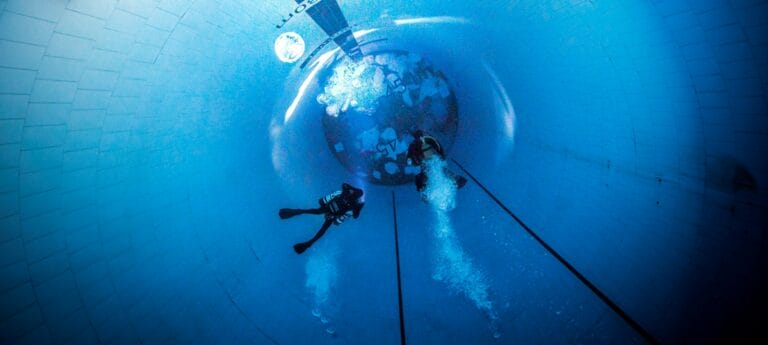Snorkeling , often interpolated as“snorkeling,” is simply viewing the underwater world through a mask with a snorkel. It requires only basic equipment, and you will need a mask, breathing tube and fins, the so-called “ABC equipment.”
What equipment to choose for snorkeling?
Snorkeling is a great way to explore the beauty of the underwater world in shallow waters – and without a course…. but nevertheless with proper preparation. To enjoy the underwater world to the fullest, it’s worth getting the right equipment that won’t fail at the crucial moment.
The mask must fit snugly on the face, the tube makes it easier to breathe, and the fins and vest increase comfort. Even if you don’t reach for specialized equipment, take care of the quality, because snorkeling becomes even safer with a well-chosen set.
Mask for snorkeling
To see well underwater, we must have a mask on. The layer of air between the eyes and the glass of the mask makes objects seen underwater sharp. Due to the refraction of light rays, things under water appear larger and closer. For example, a coin held in the hand underwater will appear unnaturally large to us. However, we will see it through the mask sharply and clearly. In the same way, we will see fish, rock formations or other snorkelers through the mask.
When choosing a mask for yourself, pay attention to ensure that it is tight when pressed against the face. This is easy to check without going into the water. Apply the mask to the face and lightly draw in air through the nose. If the mask sucks slightly to our face, it should also be tight when swimming.
When buying a mask, it is worth finding out whether the mask glass is safe in case of breakage (“tempered” label). It is also worth checking, especially if the “glass” of the mask is plastic, whether it has been protected against evaporation with a durable coating (antifog). When applying the mask, we must be careful that the hair or cap does not get under the edge of the mask – this can cause it to leak.
The mask should be shaped in such a way that the part encompassing the nose can be squeezed the nostril drips with the fingers. When snorkeling itself, this is not important, but if after some time we want to go deeper, it will enable us to equalize the pressure in the ears while submerging.
If our mask is not covered on the inside with a special anti-evaporation coating (antifog), the simplest method of preventing evaporation is to smear saliva on the inside of the mask glass even before you get the mask wet. Depending on our approach in life and our desire to behave elegantly, some people simply spit on the glass of the mask, while others (especially ladies) scoop the saliva with a finger in an elegant motion and finally spread the saliva on the inside of the mask glass. Then rinse with water and dress. Simply put, a remedy.

Snorkel tube
Tubes (often called “snorkels”) are used to breathe freely while swimming with your face submerged. Thanks to the tube, we can breathe normally without lifting our heads out of the water.
Snorkeling tubes are often equipped with special valves that make it easier to remove water from the tube if the top of the tube becomes flooded during a slight dip or wave passage. In case the tube does not have proper valves, after flooding, we can either raise our head and pour the water out of the pipe by taking it out of our mouth, or blow hard throwing out a fountain of water. If the pipe has a valve, after it is flooded, a normal exhalation is enough for the water to fly out along with the exhaled air.
Some tubes also have valves at the top to prevent flooding of the tube when the top end is submerged. There is a lot of discussion on the usefulness of these valves. If you learn to empty the water tube with an exhalation, they are not needed. If you have no experience with swimming or are buying equipment for a young child, they will be the best option.
There are also systems in which the tube is integrated into a mask that also covers the mouth. This is ideal for a person who has a fear of water.
Snorkeling fins
Typical swimming fins worn on the bare foot are the so-called calf fins. We choose the size so that they are easy to put on, but also so that the fin does not “fly” or, even more so, does not fall off when you try to kick it with your foot. If we enter the water not from a boat or sandy beach, but on the rocks or top of the reef, we can use neoprene shoes and special fins with a strap.
You should always pay attention to whether there are any designated special entry points in the area where you want to enter the water from the shore. The idea is not to damage the underwater creatures on the rocks or reef and the reef itself. It’s worth sticking to the recommendations, because first of all, we protect underwater life, and secondly, we can pay a fine for violating prohibitions.
The fins also vary in length and feather hardness. When we snorkel, we swim calmly, without rapid acceleration, so soft and medium-long fins will be best. If we buy stiff fins or very long fins (as for freediving), we will have a worse time swimming while quietly exploring or admiring nature.

How to get used to ABC equipment?
It’s worth walking in snorkeling gear to the neighborhood pool. It’s a great activity to get used to the mask, snorkel and fins, while improving lung capacity and overall fitness. Regular swimming with the face submerged teaches calm breathing, helps break the first tensions and prepares you for your first dive in the sea.
Snorkel diving does not require special skills or an expensive course, and it has the great advantage of being able to enjoy the beauty of the underwater world without having to descend to great depths.
Over time, you may become interested in freediving or scuba diving with a cylinder (you can read more about it here: Freediving and Scubadiving).
Where to snorkel after learning the basics at Deepspot?
All you need is a basic kit, knowledge of safety rules and a well-fitting mask to start exploring the underwater world: from the pool to the Red Sea, full of coral reefs and fascinating sea creatures.
Snorkeling combines elements of recreation, relaxation and adventure, and over time can become an introduction to more advanced diving, provided that we also develop swimming skills and learn to recognize, for example, zones of strong currents or choose safe places to observe the underwater world.
Egypt – the reefs of Marsaalam, Hurghada, Sharm or the iconic snorkeling at BlueHole in Dahab. When you get a chance to vacation in Egypt, snorkeling in the warm and clear waters will be the perfect way to spend the day. Whether it’s a hotel reef or a snorkeling trip with a local dive center, knowing how to handle ABC equipment will make it easier for you to enjoy the reef.
Asia – here you will find beautiful reefs, attractions such as swimming with whale sharks or a trip to a nearby lake with crystal and warm water. In many Asian countries, in addition to the typical snorkeling trips to the reefs, you can watch sharks or manta rays up close.
Snorkeling excursions combined with lunch on the white sand beach of a tranquil bay are the perfect way to spend the day.
Iceland – Silfra is a tectonic fracture between the plates of the Americas and Asia with crystal clear water and visibility of up to 100 meters. There you will find a one-of-a-kind snorkeling experience in dry suits, fully insulating your body from the sea. The sight of rugged rocks and crystal clear water is an amazing experience in naturally beautiful Iceland.
Croatia is a great place to start your snorkeling adventure, especially if you have already taken your first steps and feel comfortable in the water. All you have to do is put on your mask, jump into the crystal clear Adriatic Sea and head out to meet the underwater world.
The advantages of snorkeling in Croatia are not only the clear waters and varied coastline, but also easy access to the many coves, beaches and rocky formations that hide fish, sea urchins and colorful algae. You don’t need coral reefs here to see something interesting, even in the shallow waters there is plenty waiting to be discovered. It’s a great destination for both a family vacation and a quick getaway with a mask in your backpack.The kind of experience snorkeling in dry suits, fully insulating your body from the sea. The sight of rugged rocks and crystal clear water is an amazing experience in naturally beautiful Iceland.












